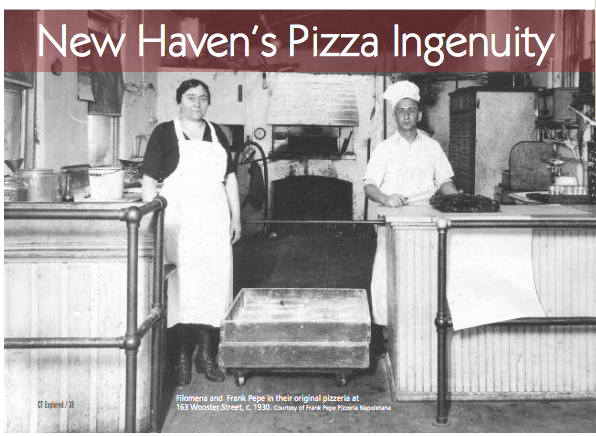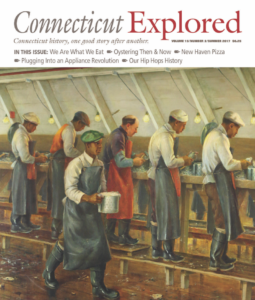
Filomena and Frank Pepe in their original pizzeria at 163 Wooster Street, c. 1930. Courtesy of Frank Pepe Pizzeria Napoletana
By Colin M. Caplan
(c) Connecticut Explored Inc. Summer 2017
SUBSCRIBE/Buy the Issue
Pizza is so central to Connecticut’s culture and life that many in the state believe it was invented here, when in fact pizza was first made in Naples, Italy. But pizza’s story here adheres to our state motto, “Qui transtulit sustinet,” which means, “He who transplanted still sustains.”
In the last quarter of the 19th century, an expanding economy in Connecticut attracted workers from across Europe and Canada to the state’s major cities. By 1910 census records indicate that New Haven’s Italian-born community was the largest per capita in the nation and the ninth largest in sheer numbers, making up more than 30 percent of the city’s total immigrant population.
The first recorded Italian bakers in New Haven were listed in the city directory in 1890. Their ovens were large coal-burning brick structures located in the bakery’s back yards—easily seen on Sanborn Insurance Maps from that period. One of the early Italian bakers was Angelo Gentile, who started his bakery in 1896 in the thickly Italian-settled Grand Avenue neighborhood. Although his primary product was bread, he also made pizza, a Neapolitan flatbread with toppings, most commonly on Friday nights when many Italians would forgo meat in observance of their Catholic faith.
There were more than 20 Italian bakeries in New Haven by 1920, and some had expanded their business to pizza-making, responding to community demand. Francesco Scelzo opened “Pizzeria Napoletana” in 1915 in the Grand Avenue neighborhood. Around the same time the Apicella family, hailing from Minore, Italy, opened bread bakeries in the Hill neighborhood. Today, only App’s Ristorante in West Haven and Apicella’s Bakery survive.
In the early 20th century it was common for Italian immigrants to sell their wares or make deliveries from peddled carts. In 1917, Ignazio “Iggy” Camposano, from Acerra, Italy, opened a bakery in the Grand Avenue neighborhood. He resettled twice before opening Camposano’s Apizza in the Hill neighborhood in 1924. Oral histories I’ve gathered indicate that he also sold his pizza in the early mornings by cart at the nearby Silver Street Market Exchange, the region’s produce depot, where Italian produce distributors and farmers eagerly awaited his hot pies.
Baker Francesco “Frank” Pepe arrived in 1920 from Maiori, Italy with his wife Filomena. At first he worked for other bakers on Wooster Street, one of the early centers of the Italian community. Wooster Street emerged as a pizza mecca in the 1930s. In 1925 Pepe rented an unused bakery, employing his wife and brother Pietro. Neighbors recall that Frank delivered bread and pizza by cart along the street, to factories, and to the produce market. Business was so good that Filomena suggested they add table service in a 1930 addition to the bakery. Frank employed his nephews Frank “Mac” Pepe, and brothers Tony and Sally Consiglio. “Mac” Pepe later opened Westville Apizza, and the Consiglios later opened Sally’s Apizza.
Many of New Haven’s Italian bakeries converted to pizzerias after the repeal of national prohibition in 1933, since pizzerias were now authorized to serve beer and remain open until three in the morning. In 1936 Frank Pepe purchased the two buildings next door, constructed a giant coal-fired bake oven, and opened a 136-seat restaurant. Frank Pepe Pizzeria Napoletana claimed in its advertisements to have the largest pizza oven in the world. Some of the remaining New Haven area pizzerias from the 1930s and 1940s include Zuppardi’s Apizza, Modern Apizza, and Mike’s Apizza.
Pizzerias began to emerge in the 1930s and 1940s in Italian enclaves outside of New Haven. In 1931, Vincenzo Verdolini opened Italian Pizzeria Restaurant in Meriden, and DePasquale Bros. Pizzeria opened in Hartford. While most of the state referred to pizza in the old Neapolitan dialect, “apizza” (pronounced “ahbeetz”), Hartford’s pizzerias revised the dialectal spelling by writing “La Pizza” in their advertising.
 It wasn’t until after World War II, when returning veterans who had been stationed in Naples, Italy brought stories of pizza home with them, that the rest of the country began discovering pizza. The introduction of gas-fired portable pizza ovens in the 1940s and 1950s also spurred the growth of pizzerias. A 1948 Salt Lake Tribune article claimed pizza would “give the national favorite, the hot dog, a run for its money,” and in 1954 The Washington Post claimed that “pizza is big business … in America’s 1,650 pizzerias.”
It wasn’t until after World War II, when returning veterans who had been stationed in Naples, Italy brought stories of pizza home with them, that the rest of the country began discovering pizza. The introduction of gas-fired portable pizza ovens in the 1940s and 1950s also spurred the growth of pizzerias. A 1948 Salt Lake Tribune article claimed pizza would “give the national favorite, the hot dog, a run for its money,” and in 1954 The Washington Post claimed that “pizza is big business … in America’s 1,650 pizzerias.”
Today New Haven is one of the top-ranked cities for pizza in the nation, according to magazine and food blogs’ pizza rankings of the last decade. More than 20 cities across the country, according to my research, serve “New Haven style pizza,” another testament to pizza’s being perhaps New Haven’s best-known export.
Colin M. Caplan is an architect, historic building consultant, and historian with Magrisso Forte. He is the author of six books about New Haven history.
Explore!
Read more stories from the Summer 2017 issue
